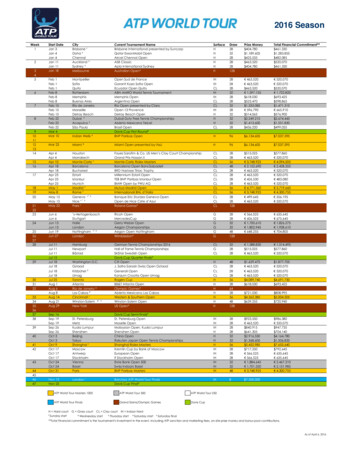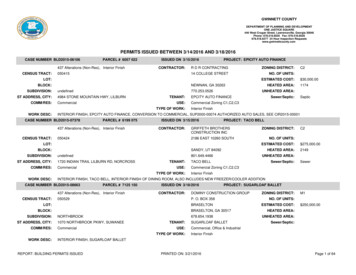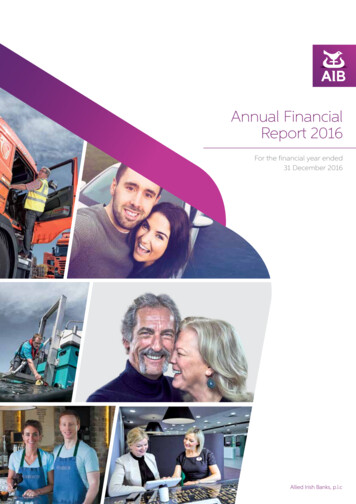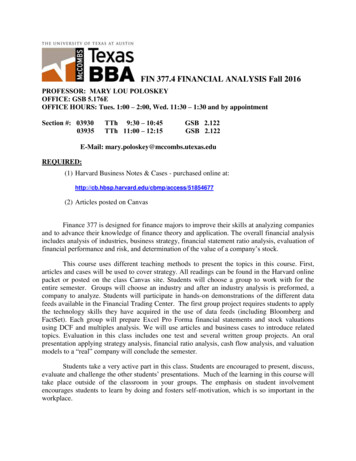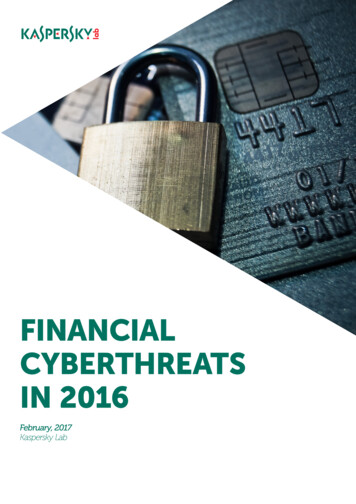
Transcription
FINANCIALCYBERTHREATSIN 2016February, 2017Kaspersky Lab
Kaspersky LabIntroduction and Key FindingsThe financial cyberthreat landscape is constantly changing. In the last couple of years,financial cybercriminals have shifted their focus from attacks against the private users ofonline banking, e-shops and payment systems, to attacks on the infrastructure of largeorganizations: banks and payment processing systems, along with retailers, hotels and otherbusinesses where POS terminals are widely used.This increase in the number of attacks against large organizations could be explained by thefact that although the preparation and execution costs of such attacks are relatively high, theoutcome may be a hundred times greater than the result of even the most successfulmalicious campaign against private users. This theory has been proved by the Carbanakfinancial cybercrime group and its “followers”, including the so-called SWIFT hackers, whowere responsible for the majority of big financial cybercrime incidents in 2016. Using nontrivial attack methods, and reducing to a minimum the use of unique malicious software infavor of open sourced tools, these groups have been able to steal millions of dollars and,unfortunately, they have not yet been caught.However, even though professional criminals have shifted their crosshairs to the big fish, thisdoesn’t mean that regular users and small and medium-sized businesses are no longer atrisk of falling victim to financial cybercrime. On the contrary: after detecting a decrease in thenumber of attacked users in 2014 and 2015, the number of victims started to grow again in2016. This report is dedicated to providing an overview of how the financial threat landscapehas evolved during the last year. It covers the phishing threats that users of Windows-basedand macOS-based computers encounter, and Windows-based and Android-based financialmalware.The key findings of the report are:Phishing: In 2016 the share of financial phishing increased 13.14 percentage points to 47.48%of all phishing detections. This result is an all-time high according to Kaspersky Labstatistics for financial phishing caught on Windows-based machines.Every fourth attempt to load a phishing page blocked by Kaspersky Lab products isrelated to banking phishing.The share of phishing related to payment systems and e-shops accounted for 11.55%and 10.14% accordingly in 2016. This is slightly (single percentage points) more thanin 2015.The share of financial phishing encountered by Mac users accounted for 31.38%.1Financial Cyberthreats in 2016
Kaspersky LabBanking malware: In 2016 the number of users attacked with banking Trojans increased by 30.55% toreach 1,088,900.17.17% of users attacked with banking malware were corporate users.Users in Russia, Germany, Japan, India, Vietnam and the US are the ones mostoften attacked by banking malware.Zbot is still the most widespread banking malware family (44.08% of attacked users)but in 2016 it was actively challenged by the Gozi family (17.22%).Android banking malware: In 2016 the number of users that encountered Android malware increased 430% toreach 305,000 worldwide. This is mostly due to a single Trojan which has beenexploiting a single security flaw in a popular mobile browser for months.Just three banking malware families accounted for attacks on the vast majority ofusers (81%).Russia, Australia and Ukraine are the countries with the highest percentage of usersattacked by Android banking malware.2Financial Cyberthreats in 2016
Kaspersky LabFinancial PhishingFinancial phishing is one of the most widespread types of cybercriminal activity. Among allexisting types of cybercrime, phishing is the most affordable in terms of the investment andlevel of technical expertise required. At the same time it is potentially profitable - in mostcases, as a result of a successful phishing campaign, a criminal would receive enoughpayment card credentials to cash out immediately, or sell the details to other criminals for agood price. Perhaps this combination of technical simplicity and effectiveness makes thistype of malicious activity attractive to amateur criminals, a pattern that we can clearly see inKaspersky Lab’s telemetry 16Fig. 1: The percentage of financial phishing detected by Kaspersky Lab in 2014-2016In 2016 Kaspersky Lab’s anti-phishing technologies detected 154,957,897 attempts to visitdifferent kinds of phishing pages. Of those, 47.48% of heuristic detections were attempts tovisit a financial phishing page. This is 13.14 percentage points more than the share ofphishing detections registered in 2015 when 34.33% of them were related to financialfraud. At the moment this is the highest percentage of financial phishing ever registered byKaspersky Lab.3Financial Cyberthreats in 2016
Kaspersky LabMoreover, for the first time in 2016, the detection of phishing pages which mimickedlegitimate banking services took first place in the overall chart, leaving the longtime leadersof this chart – global web portals and social networks - behind. In 2014 every fourth phishingpage detected was a fake online banking page or other content related to banks. However in2016, the result was 8.31 percentage points higher than in 0%0.00%20152016Fig. 2: The percentage of banking phishing detected by Kaspersky Lab in 2015-2016At Kaspersky Lab we categorize several types of phishing pages as “financial”. Besidesbanks there is also the category of “Payment Systems”, which includes pages that aremimicking well-known payment brands such as PayPal, Visa, MasterCard, AmericanExpress and others. There is also the “E-shop” category which includes Internet shops andauctions like Amazon, Apple store, Steam, E-bay and others.In 2016 both the “E-shop” and “Payment Systems” categories also showed visible growth.The share of phishing against payment systems increased by 3.75 p.p. and the attacksagainst e-shops increased 1.09 p.p. in comparison to results in 2015.4Financial Cyberthreats in 2016
Kaspersky Lab25.76%BanksPayment systems52.53%E-shopsOther11.55%10.17%Fig. 4: The distribution of different types of financial phishing detected by Kaspersky Lab in 2016The list of targets presents no surprises. Among the financial phishers’ favorite targets aretop transnational banks, popular payment systems and Internet shops and auctions from theUS, China and Brazil. The list of those targets remains the same from year to year as thepopularity of these brands remains a high and therefore lucrative target for cybercriminals.Financial phishing on MacMacOS-based computers are generally considered to have a much safer platform thanWindows. This is because the number of malware families existing for this operating systemis lower than the amount of Windows malware. However, experts often forget that phishingthreats don’t care what OS the victim’s device is running. Kaspersky Lab’s statistics showthat MacOS users often face phishing threats - if not with the same frequency as Windowsusers.In 2016 31.38% of phishing attacks against Mac-users were aimed at stealing financial data.This is much less than in 2015, when 51.46% of financial attacks blocked by Kaspersky Labwere financially-themed. However, the 2015 situation was somewhat abnormal due to a hugeamount of detections against a single international bank. The amount was so large that thisbank moved to first place among the brands most often used in phishing scams encounteredby Mac-users, leaving the usual “leaders” in the overall ratings (popular search engines andsocial networks) far behind.5Financial Cyberthreats in 2016
Kaspersky LabIn 2016 the wave of attacks against that bank decreased, bringing the overall share offinancial phishing to a more realistic level. Still, 31.38% means that one in three phishingattacks blocked on Macs were trying to lure victims into sharing their financial information.12.99%10.55%BanksE-shop7.84%Payment systemsOthers68.62%Fig. 5: the distribution of phishing attacks against Mac users in 2016This bank, which was in the crosshairs of criminals in 2015, is still the primary target ofbanking phishing, but the number of attacks is much lower.Mac vs WindowsWe also detected one allegedly platform-related feature of the financial phishing landscapeon Mac. Based on the phishing page detection statistics from Windows-based computers,the list of the most frequently used brands in the e-shop category is topped by Amazon – alongtime category “leader”. However, when it comes to Mac-phishing the leader is Apple.The latter is easy to explain: Apple’s ecosystem includes a number of recognizable andgenerally trusted web services, like iCloud, iTunes, AppStore and Apple Store. Criminals areaware of that trust and try to exploit it.When it comes to the e-commerce and payment systems categories, the particular focus onApple is not the only difference between the Mac and Windows financial phishing threatlandscapes.6Financial Cyberthreats in 2016
Kaspersky LabMacAppleAmazon.comGlobal SourcesAlibaba GroupeBaySteamNetsuiteBell CanadaBharti Airtel a GroupBell CanadaNOVA PONTOCOMWal-MartFig. 6: The most frequently used brands in “E-shop” financial phishing schemesMacPayPalAmerican ExpressMasterCardVisa Inc.qiwi.ruXoomNACHASkrill Ltd.Western UnionWindowsPayPalVisa Inc.American ExpressMasterCardWestern Unionqiwi.ruCielo S.A.Skrill Ltd.eWalletFig. 7: The most frequently used brands in “Payment Systems” financial phishing schemesIt is really hard to explain why the target profile on Macs is different to the one on Windows. Itcould be due to a difference in the consumer habits of Windows and Mac users, or it couldbe just the result of the distribution of Kaspersky Lab product users. However, the tablesabove can serve as an advice list for the users of the corresponding systems: they illustratethat criminals will use these well-known names in an attempt to illegally obtain user paymentcard, online banking and payment system credentials.7Financial Cyberthreats in 2016
Kaspersky LabPhishing campaign themesBesides a growing interest in phishing among amateur cybercriminals, the increase infinancial phishing attacks may be explained by a rather “natural” reason: a rise in the use ofonline banking, e-shops and payment systems. With the audience for these servicesgrowing, it is also probable that the number of financial phishing detections will increase.This is the conclusion drawn from the topics that criminals use in their scams. The list oftopics is not limited to fairly old copies of online banking, payment systems or Internet shopweb pages.For example, in 2016 Kaspersky Lab analysts witnessed campaigns in which criminalsdisguised their phishing message as an e-mail from an electricity provider.Fig. 8: The phishing message sent in the name of an electricity company.The message contained the link to an external page, where the electricity bill summary wasallegedly displayed. Of course that wasn’t real, the website actually belonged to a criminaland was built to collect critical user information.In another example criminals exploited the ability to transfer money from cards issued by onebank, to cards issued by another, with no or minimal fee. Such services are popular inRussia and some neighboring countries.8Financial Cyberthreats in 2016
Kaspersky LabFig. 9: A fake service offering quick card-to-card transfers with no additional feesIn this case fraudsters went to considerable efforts to build a website that looked veryprofessional, and which bluntly asks visitors to insert all possible information about theirplastic card from which money is supposed to be taken, as well as basic data about the cardto which money should be transferred. Even though websites with such design parametershave been taken down multiple times in previous years, the criminals behind them have beenpersistent and have resurrected their websites on new domains over and over again. This, initself, may be an indicator of the success that this scam has brought to its authors.Local specifics are not only exploited by criminals in Russia. It is no secret that so-calledboleto – special payment documents that are widely used in Brazil – have unfortunately beenused by criminals as well as regular users. In this next example criminals created a fakeInternet shop webpage offering TV sets for a significantly lower price than usual, but only ifpayment is made through boleto. If the victim clicks the link they are redirected to anidentification page, where critical payment data is required.9Financial Cyberthreats in 2016
Kaspersky LabFig. 10: The boleto-based phishing schemeOnce a victim has entered their data in boleto, they are required to go to an ATM or bank topay in cash for their purchase. The credentials that the money should be transferred to,belong not to the real e-shop, but to an entity set up by the criminals. The victim thinks thatthey are paying an e-shop for a TV set, but in reality their money will go to criminals.10Financial Cyberthreats in 2016
Kaspersky LabAnother rather unique feature of this particular fraud scheme is that it was hosted on alegitimate domain owned by a bank. This fact makes the whole scheme more dangerous,because it looks very trusted from the victim’s point of view.Along with increasing the scale of attacks, cybercriminals are constantly improving the qualityof the pages they lure users to visit and use.Another unusual type of phishing is the example where the target of the fraudulent campaignwasn’t the bank, the payment system or e-shop, but a well-known American organizationwhich, among other things, provides car buying, insurance, financial and retirement planningservices.Fig. 11: An example of a phishing page mimicking the legitimate multiservi
Kaspersky Lab Financial Cyberthreats in 2016 2 Banking malware: In 2016 the number of users attacked with banking Trojans increased by 30.55% to reach 1,088,900. 17.17% of users attacked with banking malware were corporate users. Users in Russia, Germany, Japan, India, Vietnam and the US are the ones most

